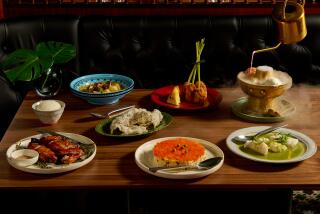The butterfly effect
A century ago, the empress dowager of China, already in her 70s, was portrayed in the West as an evil manipulator who killed off her rivals with poison cakes and indulged her sexual obsessions with a stable of male courtiers in the Forbidden City while the empire around her teetered at the edge of collapse.
Tsu Hsi died in 1908, and the imperial system fell three years later. She certainly took part in perpetuating an outdated regime. And with court politics quite secret, historians still debate whether she had a hand in the mysterious deaths of other contenders for Chinaâs throne, including her own son.
Yet the wild stories printed in Western newspapers and books about Tsu Hsi were preposterous. And eagerly swallowed. When a British scholar later wrote of her bizarre sexual practices in repeated encounters with him -- he was 29, she was 67 -- his book was a sensation in Britain, widely accepted as proof that a true Dragon Lady had lived and breathed in the Orient. Not until 1974 was the book exposed as a hoax.
The cultural divide between East and West is so vast, even in these days of easy travel and instant access, that people on either side often want to believe remarkably inaccurate notions about those on the other.
The empress dowagerâs story is one instance, but others abound in books and movies, and particularly in the minds of Western men who pursue Asian women, writes Sheridan Prasso in âThe Asian Mystique,â a compelling study of Occidental misperceptions about Asia.
âMystery and sex, fear, and desire,â writes Prasso, a former Asia editor for Business Week. âThe âOrientâ has always meant lands far away, full of opulence and sensuality, danger, depravity, and opportunity.â
Prasso argues persuasively that Western misunderstanding of Asia is routinely based on fantasy, positive or negative. There are consequences in diplomacy and business, but most of all in personal relations, particularly for Western men afflicted with what she calls âyellow fever,â the idealization of Asian women as feminine, attentive and seductive. Dragon ladies may exist, but sex goddesses abound.
If âThe Asian Mystiqueâ is not as literary as the 1978 classic âOrientalism,â Edward Saidâs masterful study of Western attitudes toward the East, it is a contemporary update on the same phenomenon: how Westerners project their hopes and fears onto whatever Asian culture they examine.
A journalist who spent 15 years writing about Asia, Prasso is realistic about the dynamics of power and sensitive to the vagaries of culture and sexuality. Her energetic reporting and depth of experience in Asia enable her to identify the superficial cultural practices that generate misunderstandings, such as politeness and self-denial in early encounters and letting true feelings emerge over time.
At a nightclub in Bangkok, Prasso surveys white male customers who are riveted by the supple flesh of delicate Asian bodies and drawn by a cultural dynamic that they seem unaware of. âIt is an easy purchase,â she writes, âthis experience of Asia that is fantasy-indulging and, ultimately, âremasculatingâ -- engendering feelings of masculinity or dominance which these Western men may have found diminished in their own cultures.â
Prassoâs book is split in two. One half analyzes the mistaken ideas that Westerners have about Asia. The other offers portraits of Asian women without mystique: housewives in Japan, bar girls in the Philippines, flight attendants on Cathay Pacific Airways, college students in China. With her skill at getting women to talk about deeply personal issues, the author reveals them as human beings, prone to the same frailties, resilience and misconceptions as people anywhere.
Prasso seizes on âMadame Butterflyâ as the archetypal story of Western notions about the Asian mystique: a delicate Japanese woman with undying love for a dashing American naval officer. It is the loyal, self-sacrificing Asian beauty who is betrayed by a fickle Westerner, a story theatrically replayed in âMiss Saigonâ and thoughtfully dissected in âM. Butterfly.â
Prasso is less persuasive when she argues that Hollywood has been the âincubator and firing kilnâ for misreadings of Asia. She documents Asian movie roles through the decades, a catalog of racist stereotyping that makes for amusing reading but feels overblown. Were movie producers really responsible for the Western misreading of Asia? Or, more likely, simply eager to make money from prejudice that already existed?
Prassoâs personal experience is also missing. Having lived in Cambodia, Hong Kong and Japan as a single white female, she acknowledges being part of a group sometimes âguilty of racist sour-grapeism,â of feeling overlooked and betrayed by Western men who are chasing Asian women. Yet she never reveals her own attractions, or lack of them, to Asians. Reading her long accounts of the sexual adventures of others, one wonders about her own impressions in this arena.
In the end, looking at a deeply foreign culture is like looking at the future -- it brings out our hopes and our fears and we imagine scenarios on either extreme. Yet the reality that eventually unfolds is inevitably more muddled, more human -- and more interesting -- than one ever imagines.
More to Read
Sign up for our Book Club newsletter
Get the latest news, events and more from the Los Angeles Times Book Club, and help us get L.A. reading and talking.
You may occasionally receive promotional content from the Los Angeles Times.








